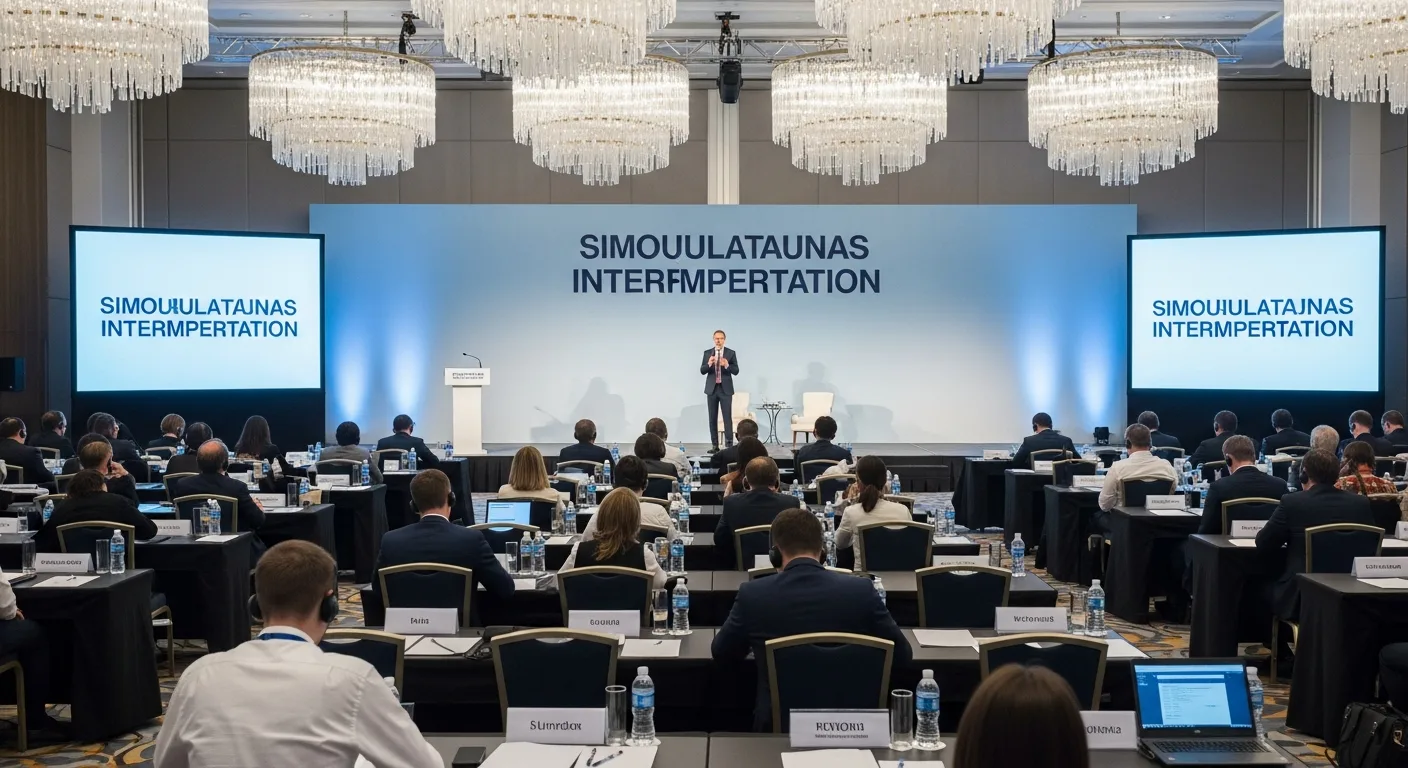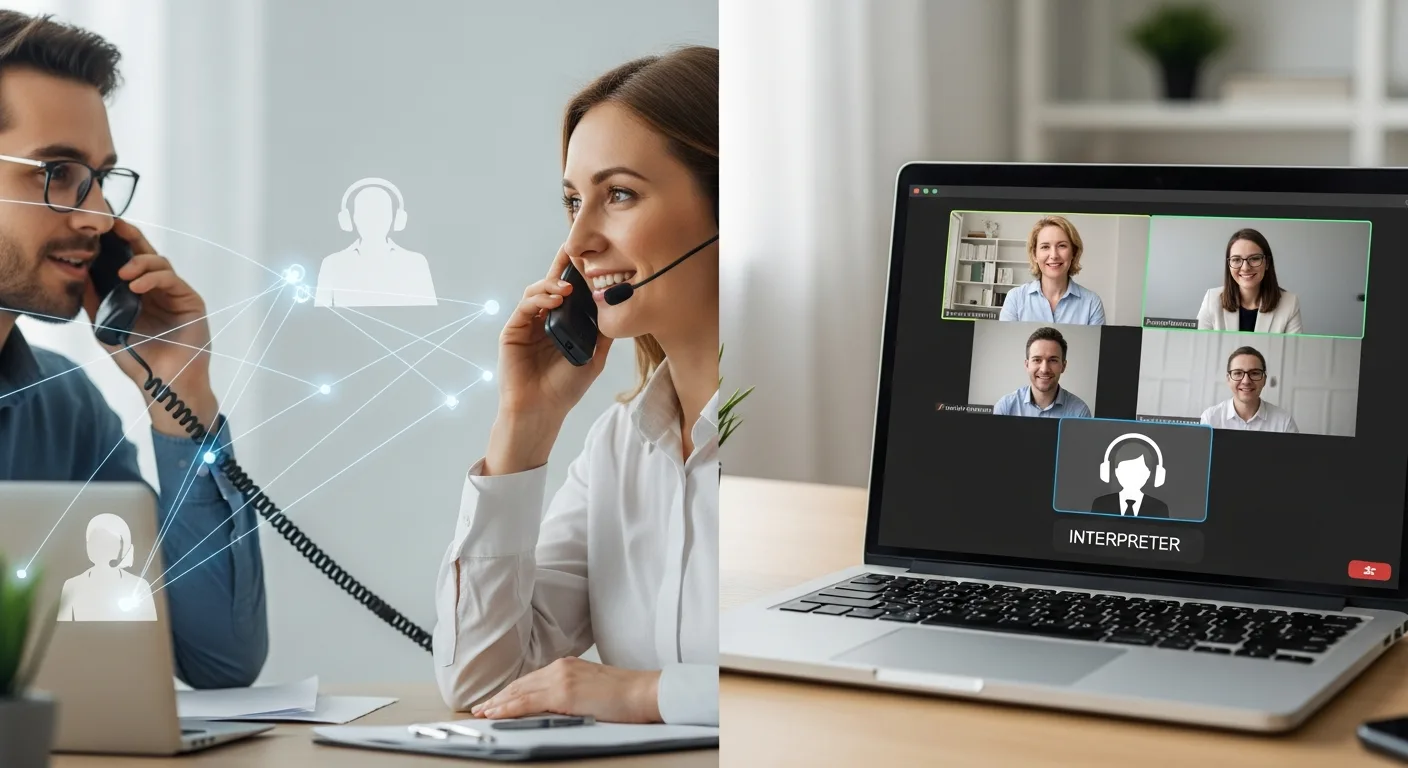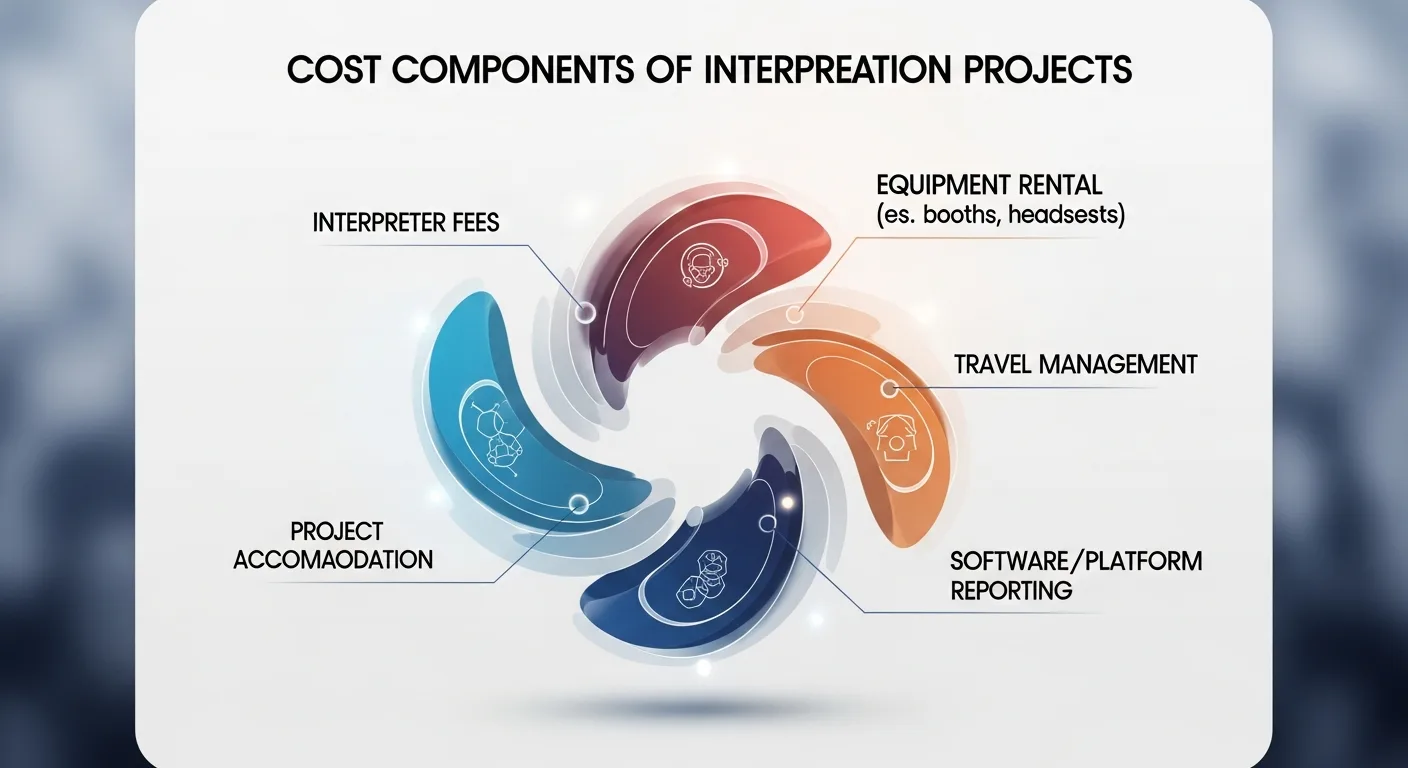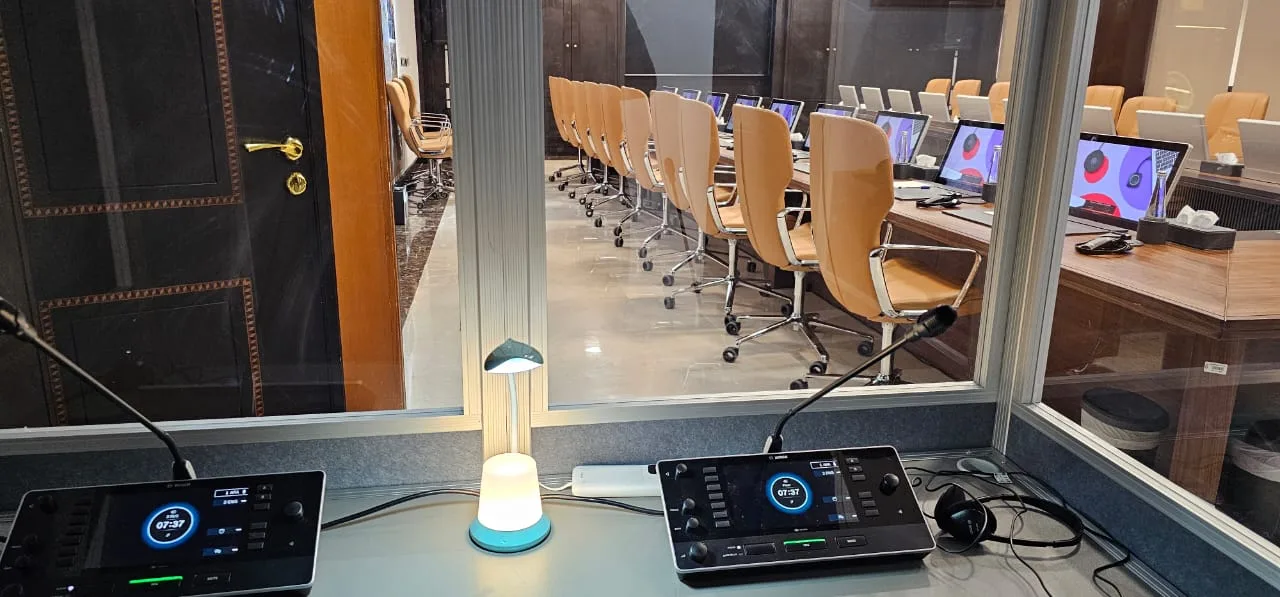Interpretation services are the backbone of clear, real-time multilingual communication. Whether you are hosting a conference with hundreds of delegates, negotiating a cross-border deal, visiting a medical facility with international patients, or welcoming an official delegation, the right interpreter transforms language differences into understanding and results. This comprehensive guide explains the major types of interpreting, how the process works, what equipment you may need, how to budget, and how to select the right provider for your use case.
As a UAE-based leader with proven expertise, Sim-trans Legal Translation & Interpretation Services supports clients with certified, legal, and general interpretation for events, meetings, and high-stakes communications across the country. Use this guide as your go-to resource to plan confidently, avoid risks, and get outstanding outcomes from your next multilingual engagement.
Quick Summary
Interpretation services deliver spoken language conversion in real time so people who do not share a language can understand each other instantly. There are several modes, including simultaneous, consecutive, liaison, and remote options by phone or video. Planning starts with defining your goals, languages, event format, audience size, content complexity, and confidentiality needs.
Most events require two interpreters per language pairing for simultaneous work, plus specialized equipment such as booths and headsets. Budgeting should factor interpreter hours, team size, equipment rental, and coordination time. For risk management, prioritize experienced, specialized interpreters, glossaries, briefings, and sound checks. When in doubt, engage an agency partner that can supply vetted interpreters, equipment, and on-site support end-to-end. Contact Sim-trans Legal Translation & Interpretation Services for expert assistance.
What Are Interpretation Services? Core Types and When to Use Each
Interpretation services convert spoken messages between languages in real time. Unlike translation, which is written, interpretation is live and interactive. The most common modes are:
Simultaneous Interpreting

The interpreter renders speech into the target language almost instantly, usually from a sound-insulated booth, while the speaker continues talking. This is essential for conferences, summits, investor days, and media broadcasts. It requires headsets, transmitters, and a professional audio chain for reliable delivery.
Consecutive Interpreting

The speaker pauses periodically, giving the interpreter time to deliver the message in the target language. Consecutive is ideal for interviews, legal depositions, clinical consultations, site visits, and small group meetings. It does not require booths, but does benefit from microphones and a quiet environment.
Whispered and Liaison Interpreting

Whispered interpreting, also called chuchotage, is a quiet, simultaneous rendition to a small audience of one to three listeners. Liaison interpreting facilitates two-way conversations in small meetings or during plant tours and inspections. Both work well for executive escort and travel interpretation scenarios.
Remote Interpretation

Telephone and video remote interpreting provide on-demand access to qualified interpreters without needing to travel. Remote is effective for routine appointments, customer support, or hybrid events. It can also serve as a contingency when travel or venue constraints arise.
Choosing a mode depends on event size, content complexity, and the pace of interaction. For multi-speaker events with large audiences, simultaneous is the gold standard. For interviews and negotiations, consecutive is commonly preferred.
Simultaneous vs Consecutive Interpreting: How to Decide
Both modes can achieve excellent comprehension when executed by professionals. Here is how to prioritize:
- Audience size: Simultaneous is best for large or mixed-language audiences; consecutive can disrupt flow with frequent pauses.
- Time constraints: Simultaneous keeps programs on schedule. Consecutive typically doubles the time for each speech segment.
- Interactivity: Consecutive supports detailed two-way conversation, note-taking, and clarifying questions.
- Equipment: Simultaneous needs booths, headsets, and AV integration; consecutive can run with microphones only.
- Budget: Consecutive may reduce equipment costs but can increase room hire and staffing if sessions run longer.
When stakes are high and time is limited, simultaneous often delivers the best audience experience. For sensitive interviews or technical walk-throughs, consecutive provides the right pacing for accuracy and nuance.
How Conference Interpreting Works: People, Process, and Equipment
Conference interpreting combines specialized interpreters, AV equipment, and a disciplined process to ensure every attendee hears a clear rendition in their language. Key elements include:
Team Roles
- Lead interpreter and partner per language pair, rotating every 20 to 30 minutes to maintain concentration.
- Chief interpreter or coordinator who manages teams, handover points, glossaries, and terminology queries.
- AV technicians who handle booths, mixers, transmitters, receivers, microphones, and recording requirements.
- Event manager who aligns run-of-show, speaker decks, and live changes.
Equipment Essentials
- ISO-compliant soundproof booths and interpreter consoles for reliable audio isolation. Know more about ISO 23155:2022 – Interpreting services standards
- RF or infrared transmitters feeding audience headsets by language channel.
- Stage microphones, lectern mics, lapel mics, and backup mics with disciplined mic handover.
- Live monitoring and a sound check protocol before doors open.
With professional planning and rehearsals, conference interpreting feels seamless to attendees. For budget-sensitive events, portable booth solutions can still achieve strong results when installed and tested by professionals.
Live Interpreter vs Live Translation: Key Differences
Clients often use the terms interchangeably, but the distinction matters. A live interpreter converts spoken words in real time, while live translation usually refers to on-screen captions or real-time text that may be machine-generated or human-edited. Interpreting prioritizes listening and speaking skills, memory, and terminology control. Live translation relies on typing speed or speech-to-text pipelines. For events where voice carries meaning, tone, and emotion, interpretation services are the right fit. For accessibility or transcripts, live translation complements interpretation with real-time captions and post-event records.
Business Interpreting Services: Meetings, Negotiations, and Operations
Business interpretation services supports cross-functional collaboration and decision-making. Typical scenarios include executive briefings, board meetings, vendor negotiations, product demonstrations, due diligence site visits, safety inductions, and training sessions. Success depends on selecting interpreters with business acumen, industry exposure, and impeccable confidentiality. Provide briefs, participant lists, organization charts, agendas, and expected outcomes in advance. For plant tours, share safety requirements and personal protective equipment needs. For negotiations, define the desired tone and escalation paths so interpreters can manage pace and clarity without overstepping their neutral role.
Remote Interpretation: Phone, Video, and Hybrid Models
Remote channels expand access to interpreters and add agility. Phone interpreting is highly efficient for short, transactional interactions. Video remote interpreting adds visual context that improves accuracy for medical, legal, and technical discussions. Hybrid events combine on-site and remote interpreters. Best practices include secure platforms, reliable codecs, redundant internet connectivity, quality microphones, and a clear speaking protocol for moderators. Always schedule a sound check and fallback plan before the meeting starts.
Preparing Briefs and Glossaries for Interpreters Services
Preparation elevates accuracy and fluency. Provide the following at least 48 to 72 hours in advance when possible:
- Agenda, speaker list, and roles
- Slide decks, scripts, and key talking points
- Terminology lists, model documents, and acronyms
- Pronunciation guides for names, product terms, and locations
- Confidentiality and data handling instructions
Encourage speakers to rehearse difficult terms and to share pre-recorded content if any. Glossaries allow interpreters to maintain consistency, especially for regulated industries where terminology precision is mandatory.
Travel Interpretation for Executives and Delegations
Travel interpretation services supports VIP movements, factory tours, cultural events, and site inspections. The interpreter escorts the delegation, enabling real-time, two-way communication with hosts, vendors, and regulators. For multi-day trips, plan reasonable hours and rotation to maintain quality. Share itineraries, security protocols, dress codes, and badge requirements. For sensitive visits, a nondisclosure agreement and pre-visit briefing are recommended.
Quality Assurance and Ethics in Interpretation
Quality assurance spans selection, preparation, and performance monitoring. Agencies should vet interpreters for credentials, proven experience, and native-level proficiency. Ethical standards require neutrality, confidentiality, and cultural sensitivity. In high-stakes settings, test runs and terminology briefings are essential. For events with public exposure, request language samples or references. After the event, hold a debrief to capture improvements and update glossaries for future sessions.
Industry Applications of Interpretation Services
Interpreting is specialized work. Selecting interpreters with domain knowledge improves accuracy, speed, and audience trust. Below are common industry contexts and best practices.
Legal and Courtroom Interpreting
Law firms, corporate legal departments, immigration services companies, notary offices, and judicial environments require precise term usage and strict confidentiality. Consecutive mode is common for depositions and client meetings, while courts may prescribe simultaneous equipment. Ensure interpreters understand procedural rules, privilege implications, and document handling protocols.
Healthcare and Medical Interpreting
Hospitals, clinics, device manufacturers, insurers, and clinical research organizations rely on interpreters to ensure informed consent, accurate symptom reporting, and adherence to care plans. Specialized training in medical terminology and privacy frameworks is essential. Video remote interpreting works well for routine consultations; in-person is preferable for complex or sensitive cases.
Finance and Banking Interpretation
Banks, investment firms, accounting practices, and insurers conduct due diligence, audits, and investor meetings where precision, speed, and discretion are paramount. Share financial statements, term sheets, and compliance requirements in advance. Simultaneous mode supports efficient analyst briefings and AGM events.
Government, Embassies, and Public Services
Embassies, consulates, and public service offices work under protocol, strict timelines, and public scrutiny. Interpreters must be familiar with diplomatic etiquette, titles, and honorifics. Provide protocol briefs, seating charts, and speaking orders to minimize disruption.
Technical, Engineering, and Industrial Settings
IT companies, cybersecurity firms, SaaS vendors, manufacturers, engineering consultancies, industrial compliance teams, and logistics providers depend on interpreters who can decode acronyms, specs, and standards. For FATs and SATs, plan for noise control and safety. Whispered interpreting with tour guide systems can be effective on the factory floor.
Events, Media, and Creative Industries
Hotels, travel agencies, tourism companies, film producers, publishers, broadcasters, licensing authorities, recruiters, and NGOs often run complex programs with multilingual audiences. Conference interpreting with professional AV integration ensures a premium participant experience and protects brand reputation.
How To Choose and Book Interpretation Services
Professional planning reduces risk and improves outcomes. Use the following frameworks and checklists when evaluating providers and preparing your team.
Choose the Right Interpreter
- Match interpreters to subject matter: legal, medical, finance, engineering, or media.
- Verify credentials, references, and portfolio of similar events.
- Assess native or near-native proficiency in both working languages.
- Confirm availability for the full schedule and potential overtime.
- Require NDAs for confidential matters.
Step-by-Step Booking Checklist
- Define goals, audience, languages, and success criteria.
- Select mode: simultaneous, consecutive, liaison, or remote.
- Estimate team size and hours, including breaks and rotations.
- Reserve equipment and AV technicians if required.
- Share briefs, decks, and glossaries at least 48 to 72 hours ahead.
- Schedule a technical rehearsal and sound check.
- Assign a coordinator to manage live updates and Q&A.
- Plan a feedback debrief and glossary updates after the event.
Budgeting for Interpretation Services
Budget lines typically include interpreter day rates, overtime, travel, accommodation for multi-day events, equipment rental, technician time, project management, and contingency. Simultaneous interpreting usually requires two interpreters per language pair for sessions over 60 to 90 minutes. Complex agendas, fast-paced panels, or highly technical content may require larger teams.
Etiquette for Speakers and Moderators
- Speak clearly, avoid overlapping dialogue, and limit rapid-fire interruptions.
- Share final scripts or key phrases in advance when possible.
- Use microphones correctly and avoid shuffling papers near the mic.
- Allow interpreters to complete a sentence before switching speakers.
- For consecutive mode, agree on natural pause points.
Build a Multilingual Communication Strategy
Enterprises that regularly engage international stakeholders benefit from a proactive strategy: maintain a centralized terminology database, standardize workflows for booking services, train staff on interpreting etiquette, and set policies for confidentiality and data storage. This reduces friction and lifts quality across all interactions.
Interpretation Services Across the UAE: Local Insights
The UAE hosts world-class events, corporate headquarters, healthcare hubs, and research centers that demand reliable interpreting. In major cities, venue AV capabilities vary by hall, and some require specific equipment models or integration teams. Lead times for security access and vendor approvals can differ between venues. When planning multi-city roadshows or training programs, confirm power availability, booth placement, and sound isolation at each location. If your agenda includes government or diplomatic activities, adhere to protocol and security briefings. An experienced partner can coordinate equipment logistics and interpreter assignments to maintain consistency across sites.
Cost, Pricing, and Equipment: What to Expect

Pricing reflects expertise, specialization, and delivery complexity. Projects that require simultaneous interpreting, multiple language pairs, technical content, or strict confidentiality typically command higher rates. Equipment and technicians are essential investments for audience experience and risk mitigation. Below is a simplified comparison to guide decisions.
| Option | Typical Use Case | Pros | Cons
|
|---|---|---|---|
| Agency-managed team | Conferences, legal, medical, high-stakes corporate events | Vetted interpreters, backups, equipment integration, single point of contact | Higher upfront cost than freelance-only arrangements |
| Freelance-only | Small meetings, low-risk internal sessions | Potential cost savings, direct contact | No redundancy, limited equipment support, higher coordination burden |
| Remote phone or video | Short appointments, hybrid teams, routine support | Fast deployment, scalable, geographic flexibility | Dependent on platform quality and connectivity |
| On-site consecutive | Interviews, negotiations, site visits | Minimal equipment, strong two-way interaction | Longer session duration due to turn-taking |
| On-site simultaneous | Large audiences, multi-speaker events | Efficient timing, premium audience experience | Requires booths, headsets, and AV expertise |
Decision-Making Framework: Select the Right Mode and Team
Use this structured approach to determine the best-fit solution for your event or meeting.
- Define objective: inform, persuade, train, negotiate, or troubleshoot.
- Audience profile: size, languages, accessibility needs, and VIP presence.
- Content complexity: technical depth, jargon density, confidentiality.
- Interaction level: one-way speeches, panels, or active Q&A.
- Time constraints: strict schedules favor simultaneous delivery.
- Venue and AV: booth capacity, line of sight, audio paths, recording.
- Budget and risk tolerance: prioritize quality and redundancy for high stakes.
| Scenario | Recommended Mode | Team Size | Equipment
|
|---|---|---|---|
| Investor conference with 300 attendees | Simultaneous | 2 interpreters per language pair | Booths, headsets, AV techs, backup channels |
| Executive negotiation, 8 participants | Consecutive | 1 interpreter per language pair | Table mics, recording optional, NDA |
| Hybrid training with remote trainers | Video remote or hybrid | 1 to 2 interpreters per language pair | Secure platform, backup internet, quality headsets |
| Factory acceptance test on the floor | Whispered or liaison | 1 interpreter per language pair | Tour guide system, PPE, noise mitigation |
Troubleshooting and Risk Management
Even well-planned events can face challenges. Common issues include audio feedback, microphone etiquette problems, last-minute agenda changes, unexpected terminology, and platform instability for remote sessions. Mitigation strategies include redundant audio paths, backup receivers, a printed run-of-show, real-time chat channels between interpreters and coordinators, and designated roles for Q&A moderation. For confidentiality, implement NDAs, limit recording access, and define data retention schedules. ROI improves when interpretation services elevates audience understanding, reduces friction in negotiations, and accelerates decision-making.
Comparison Guide: Business Interpretation Options
Business interpretation is not one-size-fits-all. The right choice balances speed, accuracy, confidentiality, and overall audience experience. Below is a concise comparison to help you match your need to the service model.
- Business interpreting services for roadshows and investor relations prioritize simultaneous mode with professional AV.
- Internal team workshops and product training often benefit from consecutive or hybrid formats that allow questions and demos.
- Regulated discussions in legal and medical contexts demand interpreters with verified sector credentials and strict ethics.
Integrating Live Translation and Accessibility
Complement voice interpreting with live translation captions for accessibility and post-event content. When both are used, coordinate AV and platform settings to avoid audio echo, feedback, or channel confusion. Clarify to audiences how to select their language channel and whether captions or interpretation will be recorded. For multilingual media assets, plan post-production subtitling and voice-over timelines to maximize reach.
How Sim-trans Supports Your Interpretation Project
Sim-trans Legal Translation & Interpretation Services is a UAE-based partner with offices in Dubai and Abu Dhabi. We provide certified, legal, and general translation and interpretation services across the UAE. Our teams support law firms, corporate legal departments, immigration services, real estate and property developers, mortgage companies, hospitals and clinics, device manufacturers, insurers, CROs, banks, investment and accounting firms, embassies and consulates, public services, universities and colleges, scholarship boards, IT and cybersecurity firms, SaaS companies, product manufacturers, engineering consultancies, industrial compliance teams, shipping and freight forwarders, customs brokers, hotels and tourism companies, film and broadcast media, licensing departments, recruitment agencies, humanitarian organizations, international development agencies, and research foundations.
Our capabilities include on-site and remote interpreting, conference interpreting with booths and headsets, business interpretation services for boardrooms and production floors, travel interpretation for delegations, and multilingual communication support. We provide vetted interpreters, equipment rental and integration, AV technicians, project management, and quality assurance throughout your engagement.
FAQs: Interpretation Services
- What is the difference between interpretation and translation? Interpretation converts spoken language in real time. Translation converts written text. Events, meetings, and calls need interpreting, while documents, contracts, and reports require translation.
- How many interpreters do I need? For simultaneous interpreting beyond 60 to 90 minutes, plan two interpreters per language pair to rotate. For short consecutive sessions, one interpreter may suffice, subject to complexity.
- Do I need equipment for small meetings? For small consecutive sessions, microphones may be enough. Large audiences and simultaneous mode require booths, headsets, and AV integration.
- Can you handle confidential or regulated content? Yes. Professional interpreters follow strict ethics, confidentiality, and NDAs. Share security and data handling requirements in advance.
- What if speakers change at the last minute? Provide updated agendas and materials as soon as possible. A coordinator will brief the interpreting team and adjust glossaries and rotation schedules.
- Is remote interpretation as reliable as on-site? With proper platforms, audio hardware, and redundancy, remote interpreting is highly effective. Always conduct a sound check and have a fallback plan.
- How far in advance should I book? For conferences and multi-language events, 2 to 6 weeks is advisable. Complex or high-profile events may require more lead time.
- How do you ensure terminology accuracy? We request briefs, slide decks, and glossaries. Our teams prepare terminology lists and coordinate with client SMEs to confirm usage.
- Can you support multilingual Q&A and breakout rooms? Yes. We plan channel assignments, moderation rules, and interpreter coverage for each room or session.
- What drives cost the most? Language rarity, specialization, duration, simultaneous vs consecutive mode, number of language pairs, equipment needs, and short-notice bookings are the main cost drivers.
Conclusion and Next Steps
Interpretation services unlock real-time understanding for meetings, negotiations, training, and large-scale events. By aligning your objectives, audience, content, and risk tolerance with the right mode and team, you can deliver a seamless multilingual experience that builds trust and accelerates outcomes. Whether you need conference interpreting with full equipment and technicians, a live interpreter for executive negotiations, business interpreting services for a product launch, or travel interpretation for VIP delegations, a coordinated approach is key. Share materials early, establish channel and etiquette rules, and plan backups for peace of mind.
Sim-trans provides end-to-end support across the UAE, from planning and equipment to specialized interpreters and on-site coordination. Contact Sim-trans Legal Translation & Interpretation Services for expert assistance and a tailored proposal for your next event or meeting.
Related Guides and Resources
International standards for conference interpreting and ISO booth specifications


